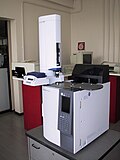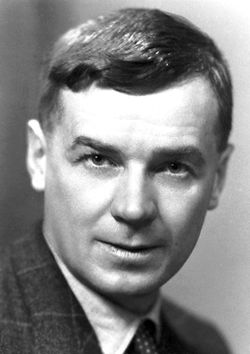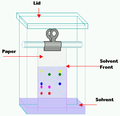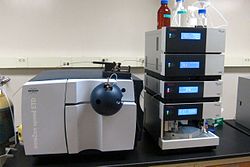Search results
Appearance
There is a page named "Partition chromatography" on Wikipedia
- sometimes known as vapor-phase chromatography (VPC), or gas–liquid partition chromatography (GLPC). These alternative names, as well as their respective abbreviations...38 KB (5,022 words) - 11:22, 26 June 2025
- Partition chromatography theory and practice was introduced through the work and publications of Archer Martin and Richard Laurence Millington Synge during...8 KB (903 words) - 21:43, 19 January 2025
- Centrifugal partition chromatography is a special chromatographic technique where both stationary and mobile phase are liquid, and the stationary phase...11 KB (1,457 words) - 09:47, 19 June 2025
- techniques of partition chromatography, and their work encouraged the rapid development of several chromatographic methods: paper chromatography, gas chromatography...58 KB (7,243 words) - 16:08, 26 June 2025
- High-performance liquid chromatography (HPLC), formerly referred to as high-pressure liquid chromatography, is a technique in analytical chemistry used...89 KB (10,969 words) - 20:19, 22 May 2025
- shared the 1952 Nobel Prize in Chemistry for the invention of partition chromatography with Richard Synge. Martin's father was a GP. Martin was educated...10 KB (793 words) - 11:32, 28 May 2025
- shared the 1952 Nobel Prize in Chemistry for the invention of partition chromatography with Archer Martin. Richard Laurence Millington Synge was born...7 KB (592 words) - 11:20, 25 November 2024
- Countercurrent chromatography (CCC, also counter-current chromatography) is a form of liquid–liquid chromatography that uses a liquid stationary phase...61 KB (7,354 words) - 06:02, 2 June 2025
- quantities of material. Separations in paper chromatography involve the principle of partition. In paper chromatography, substances are distributed between a...8 KB (1,098 words) - 08:45, 3 April 2025
- described the chromatographic mechanism for it as liquid-liquid partition chromatography where analytes elute in order of increasing polarity, a conclusion...17 KB (2,053 words) - 13:37, 23 May 2025
- adsorption chromatography, partition chromatography, ion-exchange chromatography, size-exclusion chromatography, and affinity chromatography. Among these...46 KB (5,943 words) - 11:41, 25 May 2025
- techniques, that of chromatography and that of countercurrent solvent extraction", Martin and Synge developed partition chromatography to separate chemicals...25 KB (3,027 words) - 02:55, 25 June 2025
- example is gas-liquid partition equilibrium chromatography, where an analyte equilibrates between a gas and liquid phase. Partition equilibria are described...4 KB (451 words) - 03:40, 28 May 2025
- Ion chromatography (or ion-exchange chromatography) is a form of chromatography that separates ions and ionizable polar molecules based on their affinity...54 KB (6,995 words) - 10:45, 22 June 2025
- Size-exclusion chromatography, also known as molecular sieve chromatography, is a chromatographic method in which molecules in solution are separated by...31 KB (3,901 words) - 01:50, 24 May 2025
- Gas chromatography–mass spectrometry (GC–MS) is an analytical method that combines the features of gas-chromatography and mass spectrometry to identify...38 KB (4,826 words) - 13:39, 25 May 2025
- Equilibrium chemistry (section Chromatography)Applications include acid–base, host–guest, metal–complex, solubility, partition, chromatography and redox equilibria. A chemical system is said to be in equilibrium...44 KB (6,468 words) - 04:51, 23 February 2025
- liquid chromatography such as flash or preparative chromatography (using a splitter), countercurrent or centrifugal partition chromatography and supercritical...5 KB (626 words) - 01:29, 24 May 2025
- Size-exclusion chromatography (SEC) Affinity chromatography Centrifugal partition chromatography Gas chromatography and Inverse gas chromatography Crystallization...8 KB (936 words) - 04:17, 28 May 2025
- partition chromatography with Archer Martin. It was during his time in Leeds that he worked with Archer Martin, developing partition chromatography,...95 KB (9,552 words) - 12:45, 1 July 2025
- by Liquid Chromatography/Mass Spectrometry (9111) 2003121NIOSH Manual of Analytical Methods — Metamphetamine on Wipes by Liquid Chromatography/Mass Spectrometry
- Exclusion Chromatography & Products Molecular Exclusion Image Archer J.P. Martin – Nobel Lecture The development of partition chromatography * Richard












